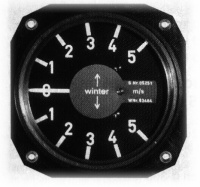AK-6
Glider Board Computer
Introduction: Variometer in a glider

The variometer is of central importance for the pilot of a glider: it shows whether the glider is climbing or sinking. This is achieved by differentiating the altimeter display, i.e. the absolute air pressure.
The glider gains altitude (conversion of kinetic energy into potential energy) by flying more slowly (pulling on the control stick), but loses it again by flying faster (pushing on the control stick) (conversion of potential energy into kinetic energy).
The glider pilot is not interested in this supposed gain in altitude, but only in the energy gain through the rise of the air mass surrounding the glider.
Total energy compensated variometers therefore include the signal from the airspeed indicator (difference between dynamic pressure and absolute pressure).
Since the 1970s, electronic variometers (E-Varios) have been available which, in contrast to the purely pneumatic ones, enable a faster, more accurate and also an acoustic display.
The Akaflieg Karlsruhe developed the AK-3 variometer with this aim in mind.
In recent years, however, development has moved on from the pure E-Vario to the on-board computer (initially with analog circuits, then increasingly microprocessor-controlled), which, in addition to the variometer display, can show, for example, the current optimum airspeed (target speed according to Mc. Cready), the distance that can still be flown with the available altitude or the position using GPS (Global Positioning System).
The ‘AK-6 Variometer Board Computer” project
The AK-6 variometer from the Akademische Fliegergruppe Karlsruhe is our second step towards developing a fully-fledged flight computer.
With the AK-4 data acquisition system, we were able to gain valuable insights into the variables that can be recorded in gliding flight. In the AK-6, these are to be calculated at the time of measurement in order to determine informative data for the pilot.
Special features compared to other flight computers are:
- The AK-6 is controlled by a HD 68HC000 microprocessor
- Large LCD display for 16×40 characters or extensive graphic displays with 240×128 pixels
- Menu-guided operation via a row of keys next to the display. The respective function of a key is displayed directly next to it
- The display and keypad are only 20 mm thick. The actual device can disappear into the luggage compartment, for example
- With different operating modes, the AK-6 offers the student pilot a minimum of confusing additional information and the cross-country pilot many decision-making aids and computer programs
- A serial RS232 interface enables communication with other computers (e.g. for software development) or data storage (recording of measurement data in flight)
- The use of an accelerometer enables a real net variometer display, calculation of turn targets, etc.
- A fully-fledged clock and stopwatch are built into the AK-6